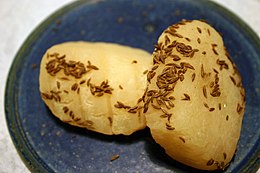| This article's tone or style may not reflect the encyclopedic tone used on Misplaced Pages. See Misplaced Pages's guide to writing better articles for suggestions. (January 2023) (Learn how and when to remove this message) |
| Handkäse | |
|---|---|
 | |
| Other names | Handkäs |
| Country of origin | Germany |
| Region | Hesse |
| Town | Frankfurt-am-Main |
| Source of milk | Cow |
| Texture | Soft but firm |
| Fat content | 1.1% to 2.3% |
| Protein content | 26.6% to 37.7% |
| Certification | PGI (Hessischer Handkäse) |

Handkäse (pronounced [ˈhantkɛːzə]; literally: "hand cheese") is a German regional sour milk cheese (similar to Harzer) and is a culinary specialty of Frankfurt am Main, Offenbach am Main, Darmstadt, Langen, and other parts of southern Hesse. It gets its name from the traditional way of producing it: forming it with one's own hands.
Handkäse is a small, translucent, yellow cheese. It has a pungent aroma, and a sour taste.
Handkäse is traditionally topped with chopped or sliced onions, locally known as "Handkäse mit Musik" (literally: hand cheese with music). It is usually eaten with caraway on it, or served on the side. Some Hessians say that it is a sign of the quality of the establishment when caraway is in a separate dispenser. As a sign of this, many restaurants have a little pot for caraway seeds.
The "music" Handkäse is supposed to be served with is often said to "come later". This is a euphemism for the flatulence that raw onions can provide during digestion. Another explanation for the "music" is that the flasks of vinegar and oil customarily provided with the cheese would supposedly strike a musical note when they hit each other. Another theory is that it was coined because, during the marinating process, the resulting gases rising up through the vinegar-oil mixture often produce a bubbling noise.
Serving
Handkäse is often served as an appetizer. Apfelwein is traditionally served with Handkäse. White wine, usually dry, is also preferred in some areas, such as Rheinhessen.
See also
References
- 2009-12-24, Council Regulation (EC) no 510/2006, "Hessischer Handkäse"/"Hessischer Handkäs", Official Journal of the European Union
- "Food Dictionary: handkäse cheese". Archived from the original on 2012-02-18. Retrieved 2009-08-14.
- "Handkäse". www.cheese.com. Retrieved 2024-08-13.
- germanfoodguide
| German cheeses | |
|---|---|
This German cuisine-related article is a stub. You can help Misplaced Pages by expanding it. |